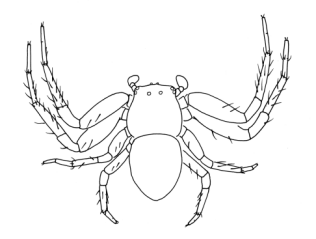I've identified this spider as a member of the genus Xysticus (Ground Crab Spider), one of the many kinds of Crab Spiders (Thomisidae) in the world. They're called "crab spiders" because, well, they resemble crabs, in that their first two pairs of legs are larger and longer than the back two, and held out in readiness like a crab's pincers. Their abdomens are also fairly flat on top, unlike the rotund ones of other families. They even move like crabs, going sideways or backwards. They have 8 eyes and can see very well.
 |
| research.amnh.org |
Notice the striped yellow-and-brown (or red) pattern on the abdomen, the orange open wedge at the back of the cephalothorax, the wide reddish stripe down the middle of the cephalothorax, and the thin yellowish stripe across the eye region. Zooming in on some photos, you can see the black eyes. Note also the solid dark red/brown color of the first two pairs of legs, as opposed to the more varied pattern on the back ones.
Ground Crab Spiders hunt along the ground. They usually move slowly, but, as I witnessed, they can head for cover quite quickly. The spider I observed provides an example of this genus's hunting tactic: it stationed itself in an area where a lot of insects were moving around (in particular, ants). There it would have waited for something to cross its path, and attacked with its long forelegs, using its strong chelicerae (jaws) to puncture the prey. Vomiting its digestive fluids into the body, in order to liquefy the contents, the spider would then have sucked out the muscles and organs, leaving a hollow shell.
I suppose the spider had been fighting with another of the same sex, probably over territory/hunting ground.
References:
http://eol.org/pages/167/details (info on family Thomisidae)
http://bugguide.net/node/view/6750 (Xysticus)
http://bugguide.net/node/view/1957 (Thomisidae)
http://delta-intkey.com/britsp/www/thomisid.htm (Thomisidae in Britain)





No comments:
Post a Comment